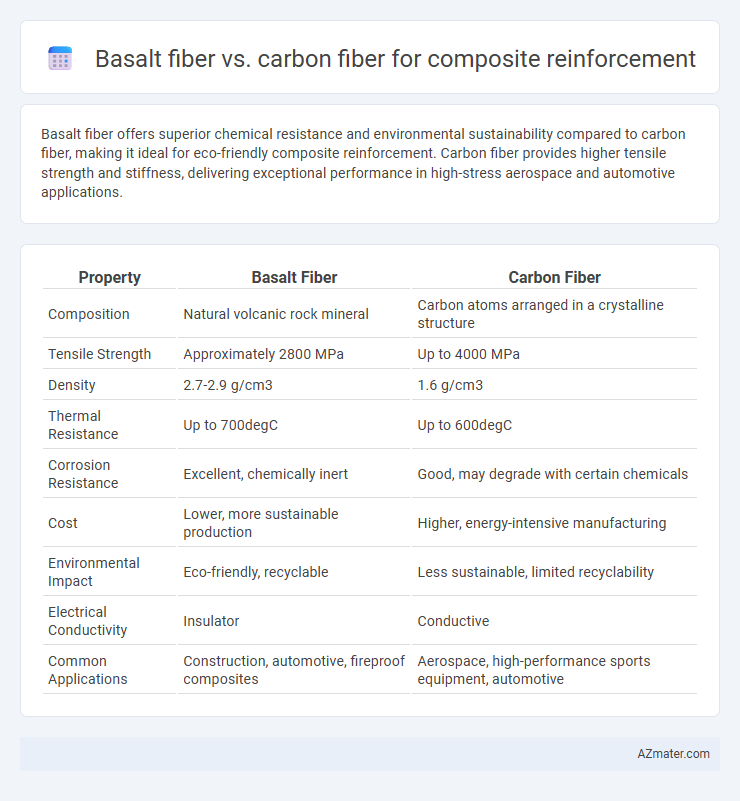Basalt fiber offers superior chemical resistance and environmental sustainability compared to carbon fiber, making it ideal for eco-friendly composite reinforcement. Carbon fiber provides higher tensile strength and stiffness, delivering exceptional performance in high-stress aerospace and automotive applications.
Table of Comparison
| Property | Basalt Fiber | Carbon Fiber |
|---|---|---|
| Composition | Natural volcanic rock mineral | Carbon atoms arranged in a crystalline structure |
| Tensile Strength | Approximately 2800 MPa | Up to 4000 MPa |
| Density | 2.7-2.9 g/cm3 | 1.6 g/cm3 |
| Thermal Resistance | Up to 700degC | Up to 600degC |
| Corrosion Resistance | Excellent, chemically inert | Good, may degrade with certain chemicals |
| Cost | Lower, more sustainable production | Higher, energy-intensive manufacturing |
| Environmental Impact | Eco-friendly, recyclable | Less sustainable, limited recyclability |
| Electrical Conductivity | Insulator | Conductive |
| Common Applications | Construction, automotive, fireproof composites | Aerospace, high-performance sports equipment, automotive |
Introduction to Composite Reinforcement Materials
Basalt fiber and carbon fiber are widely used composite reinforcement materials known for their high strength-to-weight ratios and corrosion resistance. Basalt fiber, made from volcanic rock, offers excellent thermal stability and cost-effectiveness compared to carbon fiber, which provides superior stiffness and tensile strength essential for high-performance applications. Selecting between basalt and carbon fiber depends on specific project requirements such as mechanical properties, environmental conditions, and budget constraints.
What is Basalt Fiber?
Basalt fiber is a natural composite reinforcement material derived from volcanic basalt rock, known for its high tensile strength, thermal stability, and excellent chemical resistance. It offers a cost-effective and environmentally friendly alternative to carbon fiber, with superior impact resistance and durability in harsh environments. Basalt fiber is increasingly used in automotive, construction, and aerospace industries to enhance structural performance while reducing weight.
What is Carbon Fiber?
Carbon fiber is a high-strength, lightweight material composed of thin strands of carbon atoms bonded in a crystalline structure, renowned for its exceptional tensile strength and stiffness. Commonly used in aerospace, automotive, and sports equipment industries, it offers superior performance in composite reinforcement compared to basalt fiber due to its higher modulus of elasticity and better fatigue resistance. Carbon fiber's low density and resistance to corrosion make it ideal for applications requiring durability and precision under mechanical stress.
Mechanical Properties: Basalt Fiber vs Carbon Fiber
Basalt fiber offers high tensile strength ranging from 2,500 to 3,100 MPa, closely rivaling carbon fiber's tensile strength of approximately 3,500 MPa, while providing better impact resistance and higher elongation at break. Carbon fiber exhibits superior stiffness with a modulus of elasticity around 230 GPa, compared to basalt fiber's modulus typically between 85 and 110 GPa, making carbon fiber the preferred choice for applications demanding maximum rigidity. Basalt fiber's superior thermal stability and resistance to chemical degradation make it advantageous in harsh environments, whereas carbon fiber provides exceptional fatigue resistance crucial for long-term structural applications.
Durability and Environmental Resistance
Basalt fiber exhibits superior environmental resistance compared to carbon fiber, providing exceptional durability against high temperatures, corrosion, and UV radiation, making it ideal for harsh outdoor applications. Carbon fiber offers high strength-to-weight ratio but is more susceptible to damage from moisture and chemicals, which can compromise long-term performance in aggressive environments. Basalt fiber's natural volcanic origin contributes to its enhanced resistance to alkalis and acids, ensuring prolonged structural integrity in composite reinforcement applications.
Weight and Density Comparison
Basalt fiber offers a density of approximately 2.65-2.7 g/cm3, making it slightly heavier than carbon fiber, which typically ranges from 1.75-1.95 g/cm3. Despite this higher density, basalt fiber provides excellent mechanical properties and corrosion resistance at a lower cost, though carbon fiber remains superior in strength-to-weight ratio and stiffness. For applications prioritizing lightweight composites, carbon fiber is favored, whereas basalt fiber suits scenarios where cost-effectiveness and durability balance with moderate weight are essential.
Cost Analysis: Basalt Fiber vs Carbon Fiber
Basalt fiber offers a significantly lower cost compared to carbon fiber, often priced at 30-50% less per kilogram, making it a more budget-friendly option for composite reinforcement. While carbon fiber excels in tensile strength and stiffness, its higher manufacturing expenses and raw material costs increase overall project budgets. Basalt fiber provides a balanced performance with cost-efficiency, ideal for applications requiring moderate strength and durability without the premium price tag of carbon fiber composites.
Applications in Construction and Industry
Basalt fiber offers enhanced thermal stability and corrosion resistance, making it ideal for construction applications such as concrete reinforcement, seismic retrofitting, and infrastructure durability. Carbon fiber provides superior tensile strength and stiffness, preferred in high-performance industrial uses like aerospace components, automotive manufacturing, and pressure vessels. Both fibers contribute to lightweight, high-strength composites, but basalt fiber is cost-effective with better environmental resistance, while carbon fiber excels in strength-critical industrial assemblies.
Sustainability and Environmental Impact
Basalt fiber offers superior sustainability compared to carbon fiber due to its natural origin from volcanic rock and energy-efficient production processes that generate lower CO2 emissions. Unlike carbon fiber, which relies on energy-intensive manufacturing and non-renewable raw materials, basalt fiber is fully recyclable and non-toxic, reducing environmental impact throughout its lifecycle. This makes basalt fiber an eco-friendly alternative for composite reinforcement, promoting greener construction and manufacturing industries.
Choosing the Right Fiber for Your Composite Needs
Basalt fiber offers excellent thermal resistance and cost-effectiveness, making it ideal for applications requiring durability under high temperatures and budget constraints. Carbon fiber provides superior tensile strength and stiffness, suitable for high-performance composites in aerospace and automotive industries where weight reduction and structural integrity are critical. Evaluating specific project requirements such as mechanical properties, environmental exposure, and budget helps determine the optimal fiber choice for composite reinforcement.

Infographic: Basalt fiber vs Carbon fiber for Composite reinforcement
 azmater.com
azmater.com